Authentic Scottish Dundee Cake
This post may contain affiliate links. See my disclosure policy.
A thoroughly authentic Scottish Dundee Cake recipe! Immediately recognizable by its trademark design of concentrically positioned almonds, this famous orange, raisin and almond cake is one of Scotland’s culinary treasures. Wonderfully flavorful and aromatic, it’s said to be Queen Elizabeth’s favorite cake for tea-time!
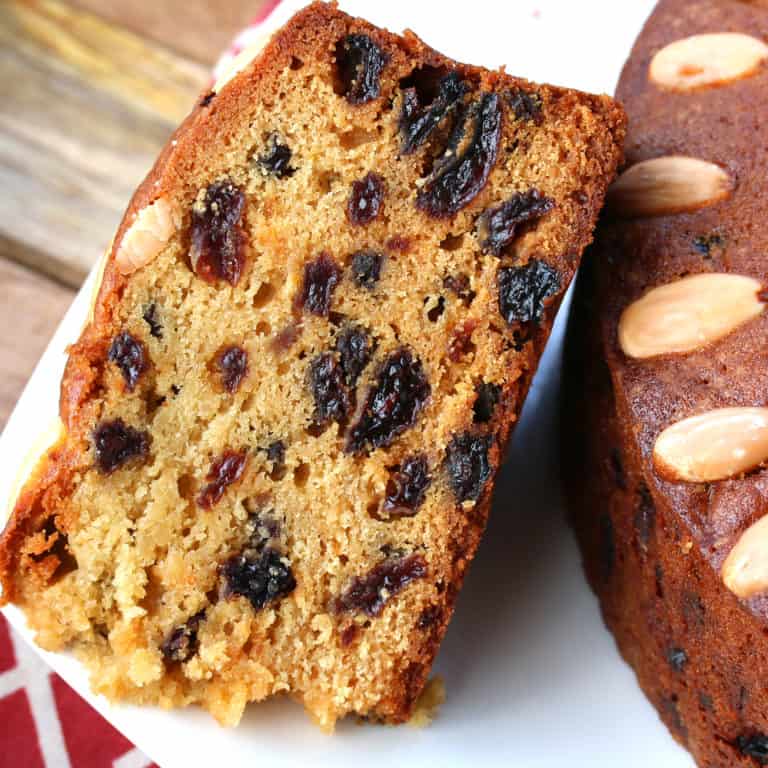
Will the REAL Scottish Dundee Cake Stand Up?
Everyone with glacé cherries sit down. Everyone with mixed spice or gingerbread spices have a seat as well. Anyone with whisky, brandy or rum sit down also…
There are endless varieties of Dundee Cake out there and the vast majority are imposters. But that holds true for many old, traditional dishes that someone somewhere decided to alter and over time the original ingredients became mingled with others until the version that became the most common no longer resembled the original version.
Is that always a bad thing? No. Variations on traditional recipes taste perfectly good. They’re just not…traditional. They’re not the real deal.
In the case of Scottish Dundee Cake the vast majority of the recipes out there are really just an English fruit cake with the almonds across the top to make it “look” like a Dundee cake. But the traditional version of Scotland’s prized Dundee cake is something quite different.
Authentic Scottish Dundee Cake
Besides the flour, butter, sugar, eggs, baking powder and touch of salt, the only other ingredients in an authentic Dundee cake are raisins and/or sultanas, orange zest, almonds, and Seville marmalade. That means no other dried fruits or nuts, not glacé cherries, no gingerbread or other spices, and no whiskey, brandy or rum.
What sets Dundee Cake apart from any others is its featured flavor: Orange. And not just any orange, specifically the sweet-bitter Seville orange with its own unique and characteristic flavor. All of the other ingredients serve to support that flavor and not take away from or dilute it.
What we have in a true Dundee cake is a much lighter and delicately flavored cake that showcases that Seville orange flavor along with the added sweetness of raisins and sultanas, and the additional flavor and delightful crunch of almonds. A true Scottish Dundee Cake hasn’t been altered to taste like the mainstream fruit cakes we all know, instead it has a very unique flavor all to its own.
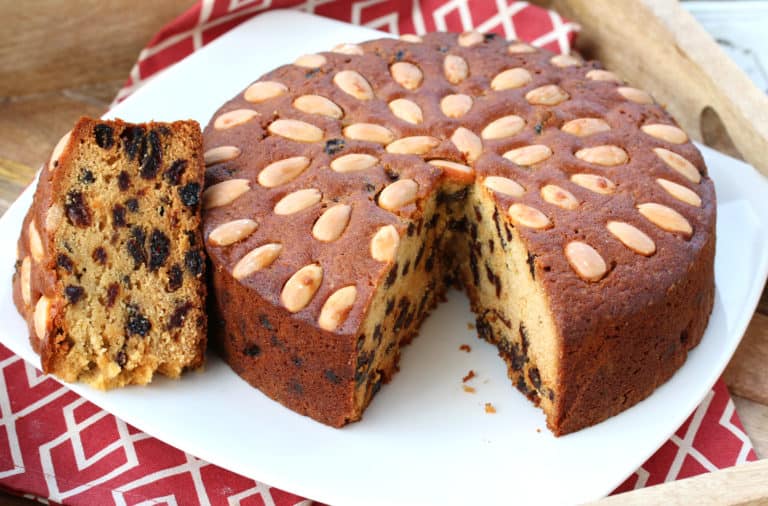
The History of Dundee Cake
There are some varying accounts but food historians believe that the Dundee cake dates back to the 1600’s and is attributed to Mary Queen of Scots (who incidentally is my great+ grandmother on my father’s side. I used to think all of my royal connections made me special until I found out that virtually everybody with European ancestry has royal lines once you get back to a certain point. So depending on how you choose to look at it, that means we’re either all special together or that nobody is special since we’re all…uh…special). In any case, Mary apparently hated glacé cherries (something I inherited from her) and wasn’t fond of the traditional fruit cakes either (same here, unless I’m using homemade candied citrus peel).
So her royal cook made her a cake that simply had raisins/sultanas and almonds in it but also featured a very unique ingredient that would forever set the Dundee cake apart from any other. It featured the subtle but striking flavor of Seville oranges that were being imported into the Scottish port town of Dundee via Spanish merchants sailing up from Spain. The original cake also used Spanish sultanas and almonds. Evidently she liked it because the cook lived to make many more and the cake soon made history.

Fast forward to the 18th century: The Keiller Marmalade Factory in Scotland started making Seville orange marmalade and marketed it in conjunction with the Dundee cake. Ever since then, instead of using Seville orange peel the Dundee cake has been made with Seville orange marmalade. This not only makes Seville oranges more accessible during off season and in other parts of the world, it also contributes the extra sweetness to the otherwise bitter oranges.
Some historians have wondered if it was in fact the Keiller Marmalade Factory who created the first Dundee cake instead of Mary Queen of Scots’ cook. But what we do know for certain is that the credit of using of the Seville orange marmalade goes to Keiller and it may also be that Keiller created the striking and instantly recognizable design of the concentric rings of whole blanched almonds on top of the cake which also add an positively delightful “crunch”.
By the 19th century the Dundee cake became popular throughout the tea rooms of Great Britain and was the dessert of choice for tea-time for both Winston Churchill and Queen Elizabeth II.
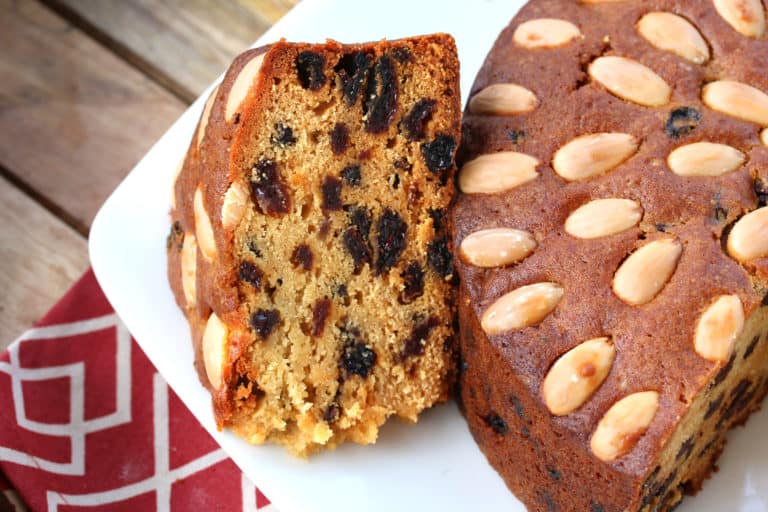
Authentic Dundee Cake Recipe
Let’s get started!
Be sure to use Seville orange marmalade for an authentic-tasting Dundee cake. I brought a few jars back with me from our trip to Scotland last year. I’ve seen Mackay’s Dundee Orange Marmalade at World Market, in some large grocery chain stores (e.g., Albertson’s), speciality stores, and you can find Mackay’s Dundee Orange Marmalade on Amazon. You can also find the original Keiller Orange Marmalade on Amazon. Note, there are other brands of Seville orange marmalade, just pick a good one because they are not all of equal quality.
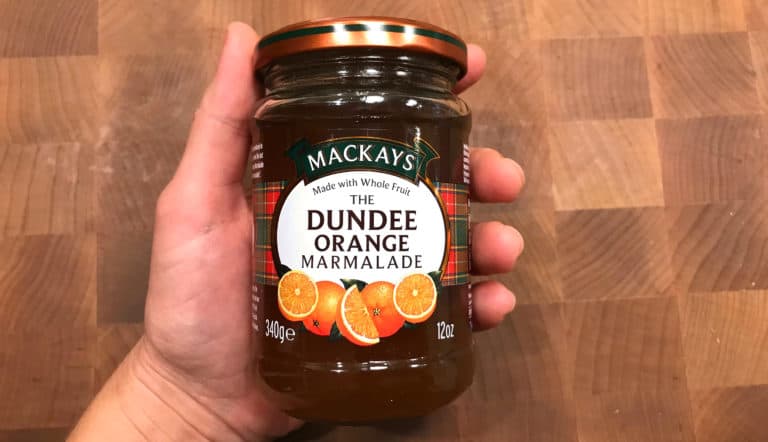
Cream the sugar and butter until pale and fluffy.

Add the eggs, one at a time, along with a teaspoon or so of the flour to prevent curdling.
Add the orange zest and marmalade and beat until combined.
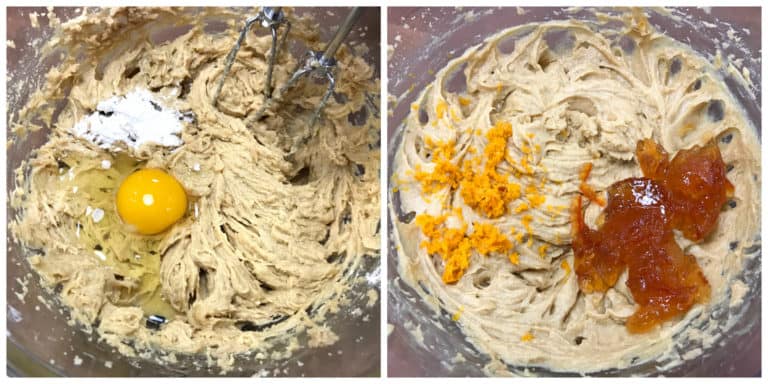
Stir together the flour, baking powder, and salt and almond flour. Add this mixture to the wet mixture and stir gently to combine, being careful not to over-stir.
Add the sultanas and raisins and stir to combine.

Grease and line an 8×3 inch round cake pan (alternatively a 9 inch round cake pan).
Spoon the batter into the prepared cake pan.
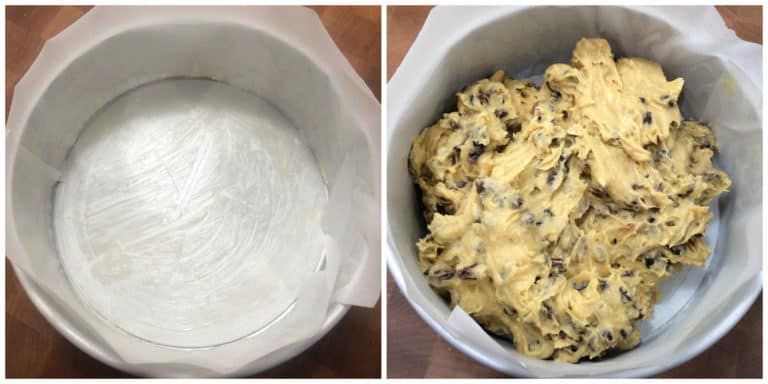
Smooth the top of it using wetted fingertips or the back of a wet spoon.
You’ll need roughly 20 whole blanched almonds for the top. See the “note” in the recipe box for directions on how to blanch the almonds (ie, remove the peels).
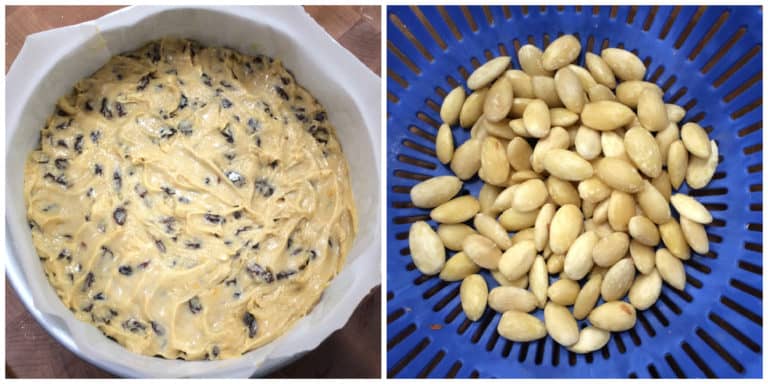
Preheat the oven to 300 F.
Arrange the almonds on top of the cake in concentric circles. Position the cake on the middle rack of the oven and bake for 100-120 minutes or until a toothpick inserted into the center comes out clean. If the cake browns too quickly cover it with aluminum foil.
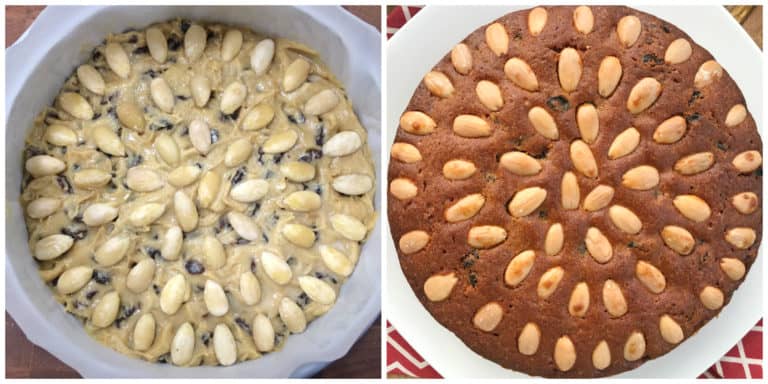
Let the cake cool in the pan for about 10 minutes.
Remove it from the pan and place it on a wire rack to cool completely.
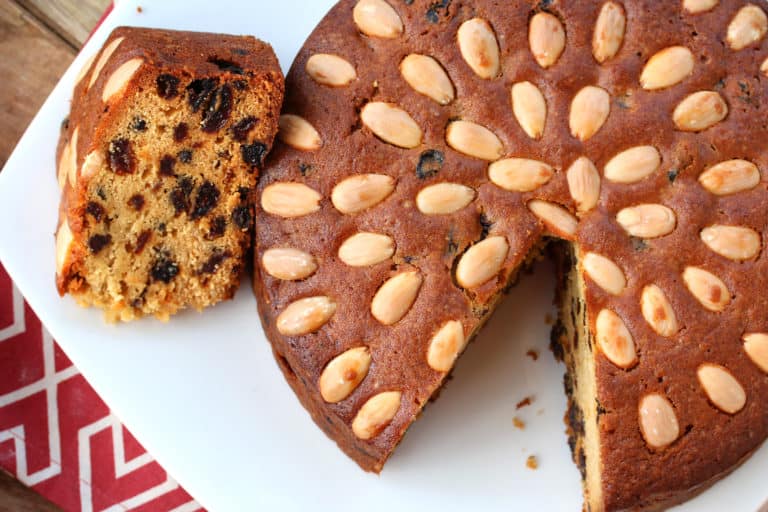
Storage and Freezing
Store the cake in an airtight tin at room temperature. To ensure it stays moist you can wrap it and then put it in the tin. It will keep for about a week.
Dundee cake can also be frozen. Wrap it well and store it in a freezer-safe container or freezer bag and it will keep fro up to 3 months. Let it thaw at room temperature.
Enjoy!
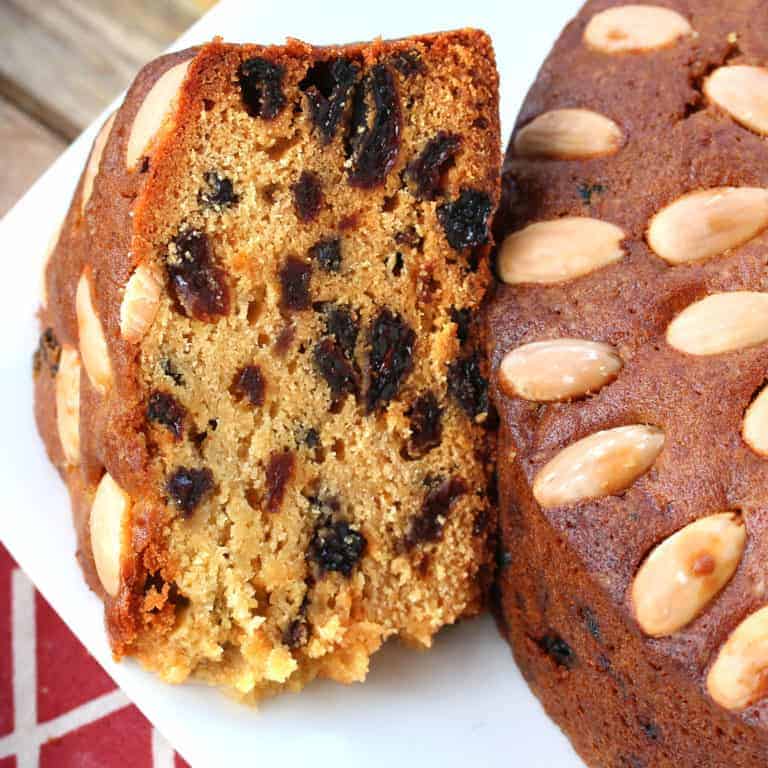
For more traditional Scottish recipes be sure to try my:
Save This Recipe
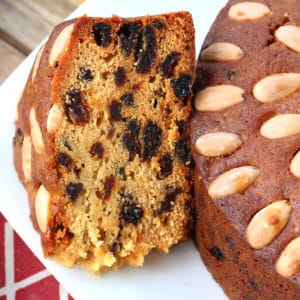
Authentic Scottish Dundee Cake
Ingredients
- 3/4 cup unsalted butter , softened at room temperature
- 1 cup firmly packed light brown sugar
- 3 large eggs
- zest of one orange (Seville if you have it)
- 5 tablespoons Seville orange marmalade
- 1 1/2 cups all-purpose flour
- 1 teaspoon baking powder
- 1/2 teaspoon salt
- 1/3 cup almond flour
- 1 1/4 cups golden raisins/sultanas (dried white grapes)
- 1 1/4 cups raisins
- 20-25 whole blanched almonds (See Note about blanching almonds yourself)
Instructions
- Grease and line a 8×3 inch round cake pan (alternatively a 9 inch round cake pan). Preheat the oven to 300 degrees F (275 F if using convection).
- Cream the sugar and butter until pale and fluffy. Add the eggs, one at a time, along with a teaspoon or so of the flour to prevent curdling. Add the orange zest and marmalade and beat until combined. Stir together the flour, baking powder, and salt and almond flour. Add this mixture to the wet mixture and stir gently to combine, being careful not to over-stir. Add the sultanas and raisins and stir to combine.
- Spoon the batter into the prepared cake pan and smooth the top of it using wetted fingertips or the back of a wet spoon. Arrange the almonds on top of the cake in concentric circles.Position the cake on the middle rack of the oven and bake for 100-120 minutes or until a toothpick inserted into the center comes out clean. If the cake browns too quickly cover it with aluminum foil. Let the cake cool in the pan for about 10 minutes before transferring it to a wire rack to cool completely.
Notes
Nutrition
Originally published on The Daring Gourmet November 25, 2019



















Delicious! Thank you for the clear instructions, it turned out perfectly and won high praises from everyone around the table.
Thank you so much, Sue! <3
I was never a fan of traditional fruit cakes. But one December, purely by accident, I stumbled across the Dundee cake! It’s the perfect cake, with sultanas for sweetness and Seville marmalade for the right amount of zing. I’ve used this recipe for the past five or six years and love it.
I’m right there with you, Edward! I’m so thrilled that you enjoyed this and that it has become a tradition in your home, thank you so very much!
You can’t beat this recipe .
This year I would like to bake them in 6 inch x4 inch deep Fat Dadio tins any recommendation for cooking times
Thank you so much, Dianne, I’m so glad you enjoyed it! For the pan size, it’s smaller but thicker and without testing it I’m not sure how much time it will need. I would check it after about hour, do a toothpick test, and bake longer as needed.
I love this recipe, however, I struggle with cups as I use ounces
Thank you, Beverley, I’m so glad you enjoyed it! I have both US Customary and Metric measurements available – you can toggle between the two by clicking on the “metric” and “us customary” buttons in the recipe box.
Wow, I am not Scottish but I live in Scotland and this was the best Dundee cake I have ever eaten. So moist and just truly delicious. Next time I’ll try it with your homemade candied peel. I am sure (if it’s possible) that it will be even better. Thank you for the recipe. It will be my go to now.
Oh I’m so glad, Val! I’m thrilled that you enjoyed it, thank you so much for the feedback!
I followed your recipe to the letter and the cake came out quite well. It did taste a bit dry and I think this is because I baked it a fully 100 minutes prior to the toothpick test. Next time I bake it, I will test before the 100 minute baking period, As I am, assuming I baked the cake a bit longer than needed. A most delicious cake and a relatively easy recipe. I did have some difficulty in removing the cake from the 8 inch Pan, therefore, I may use I may use an 8 inch springform pan to see if that works more easily. Anyway, I delicious cake and a great recipe.
Thank you for the feedback, WT, I’m happy you enjoyed it!
This is a great recipe. The cake has an excellent moist texture and the flavors are spot on. I’m enjoying a big slice of it right now.
Thank you so much for the positive feedback, Scott, I’m thrilled that you enjoyed it!
I am wondering why curdling would occur from beating sugar and butter together (step 2)?
Hi Joanne, it doesn’t occur from beating the sugar and butter together, it occurs if you add all the eggs at once to the sugar and butter, which causes the mixture to become clotted/curdled. Hence the instructions to add the eggs one at a time. This article explains the process of creating an emulsion: https://www.tasteofhome.com/article/why-do-you-have-to-add-eggs-one-at-a-time-in-baking/.